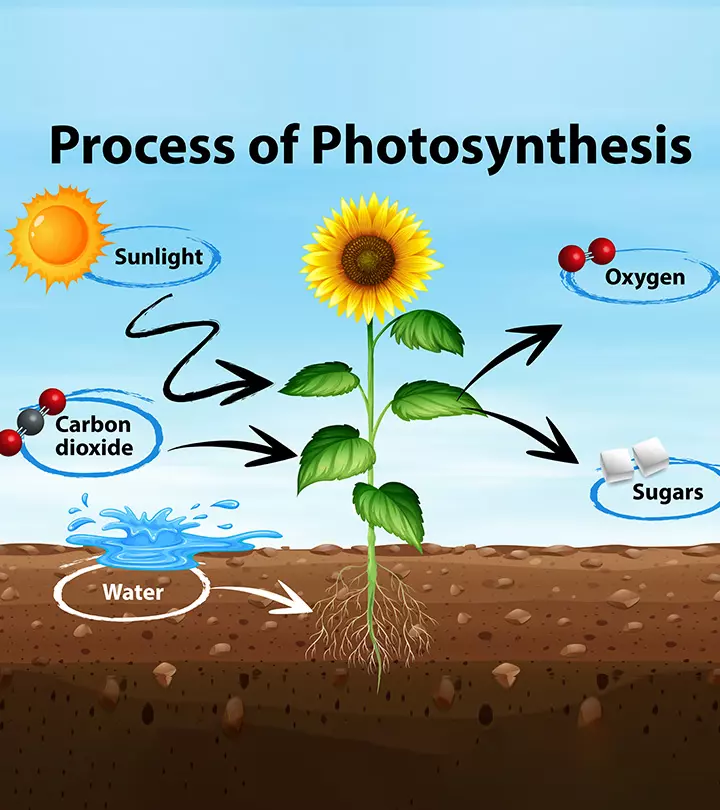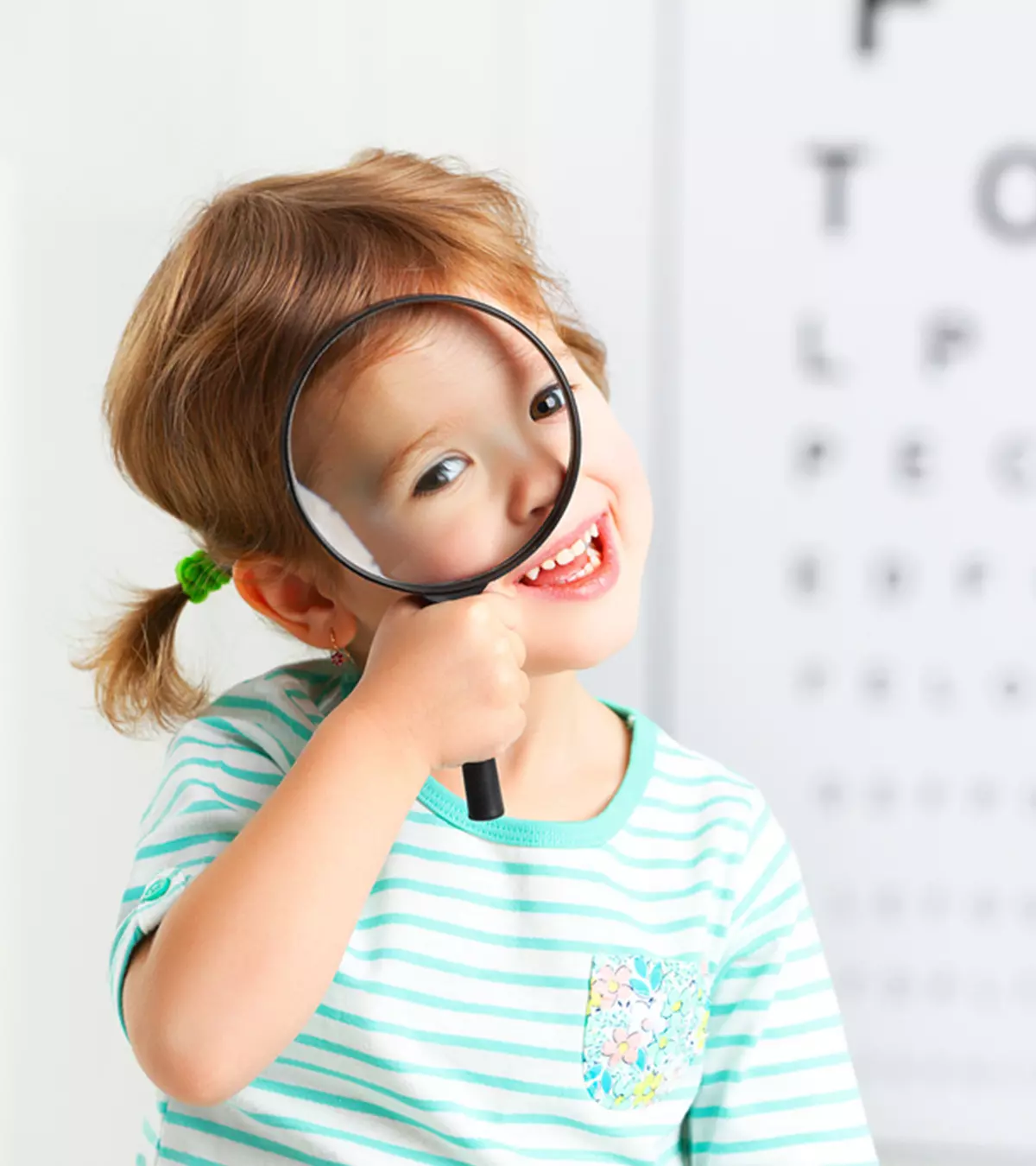
Image: ShutterStock
Many parents look for interesting facts about eyes for kids to educate their little ones about eyes and their functioning. When children understand the anatomy and functions of the eyes, it sparks curiosity and encourages them to maintain good eye health. This knowledge can inspire kids to protect their vision by adopting healthy habits early on. The eyes are the second most complex organ after the brain, allowing vision. Human eyes can differentiate about 10 million colors, and vision is one of the five senses. Nearly 80% of information is learned through vision, hence often referred to as windows of our soul.
Many children may ask questions such as “How do the eyes work?”, “Why do we cry?’, and “Why do we have two eyes?” Read on to know more eye facts for kids that can help you answer their questions.
Key Pointers
- Teaching children about the human eye encourages them to care for their eyes.
- Eyes are complex organs despite looking simplistic externally.
- Everything we view is captured upside down by the eye, and the brain flips the image.
- Interestingly, eyelashes have a limited lifespan.
Parts Of Our Eyes
Some of the following mentioned parts of your eyes are visible to us when we look in the mirror or into someone else’s eyes. However, there are other parts that cannot be seen but play important roles.
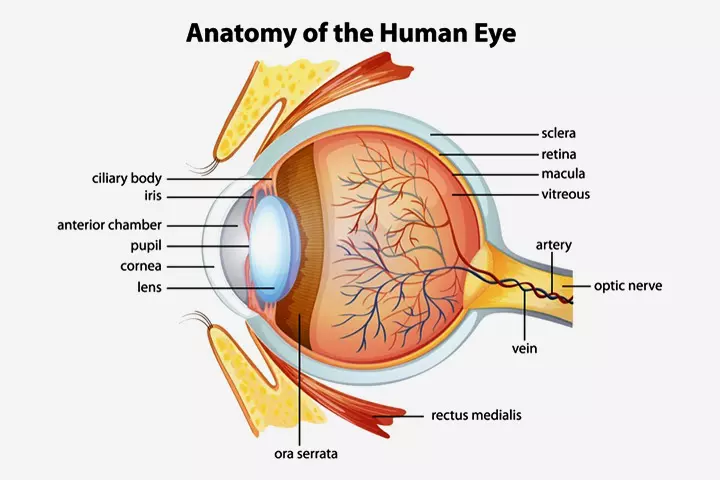
- Sclera: The white part of the eye that forms a supporting wall of the eyeball is the sclera. It is an opaque, fibrous, and protective outer layer of our eye. It is believed that because the sclera occupies the larger exposed eye surface, it is possible for us to identify where another individual is looking (1). The exterior part of the sclera is smooth and white, whereas the interior part of it is grooved and brown.
- Cornea: The transparent and bulging surface forming the front portion of the eye is the cornea. It helps in focusing vision and refracting or bending light. The cornea borders the sclera.
- Pupil: The pupil appears as a black dot in the center of the eye. It’s a hole covered by the cornea. It lets in light and focuses the light on the retina. The muscles located in the iris control the pupils (2). The amount of light, our health conditions, and our emotions affect the size of the pupil. For instance, the pupils dilate in low light and constrict when we are angry or scared (3).
- Iris: The colored part of the eye that regulates the amount of light entering the eye (which reaches the retina) is the iris (4). The iris has the pupil in the center, and the sclera surrounding it. It contains the iris sphincter muscle, also known as the pupillary muscle, and the dilator muscle, which control the diameter of the pupils when they constrict and dilate, respectively (5).
- Lens: The lens is located behind the iris and the pupil. It is a transparent, biconvex, and flexible tissue that changes its curvature to focus light on the retina (6).
- Ciliary muscles and body: These are attached to the lenses. The ciliary body produces the fluid, called aqueous humor, while the ciliary muscles help change the shape and curvature of the lens when our eyes focus on an object (6).
- Conjunctiva: The conjunctiva is a clear thin membrane covering the sclera and the inner surface of the eyelid. It helps lubricate the eye by producing mucus and tears and protects the eye from microbes. Its contribution in tear formation is very small compared to the lacrimal glands (7).
- Retina: The retina is a light-sensitive, thin layer of tissue lining the inside of the eye. It receives focused light from the lens and converts it into neural signals. These signals are transferred to the brain via the optic nerve. The conversion of light into impulses is done by photoreceptor cells in the retina. There are two types of photoreceptors:
- Rods: These provide a scotopic vision (vision in low light), as they function in low light levels. The vision provided is peripheral (or side) vision, which is important for detecting objects in the dark that are not directly in one’s sight. Rods are sensitive to movement or motion and are less sensitive to color perception. A normal retina contains approximately 120–150 million rods.
- Cones: These provide a photopic vision (vision in daylight or bright light conditions) and color vision. The vision provided is central (straight ahead). A normal retina contains approximately 6–7 million cones.
Macula, a small sensitive area located near the center of the retina, provides central vision and helps in spotting the colors and small details.
The fovea, a pit in the center of the macula, provides the sharpest detailed vision. Cones are mostly concentrated in the fovea. There is a point called the ‘blind spot’ in the retina where the optic nerve connects, and there are no light-sensitive photoreceptors at this spot (8).
- Chambers: There are three chambers in the eyes:
- The anterior chamber lies between the cornea and the iris.
- The posterior chamber lies between the iris and the lens.
- The vitreous chamber lies between the lens and the retina.
The anterior and posterior chambers are filled with the aqueous humor, and the vitreous chamber is filled with the vitreous fluid. Aqueous humor is a clear fluid that nourishes the eye and keeps it inflated (9). Vitreous humor is a clear jelly-like fluid that fills the eyeball behind the lens, supporting the eye and transmitting light to the retina. The aqueous humor and vitreous humor nourish the lens.
- Optic nerve: The optic nerve transmits all visual information from the retina to the brain. It controls the visual impulses for neurological reflexes, such as the light reflex and the accommodation reflex. It is called the second cranial nerve of the 12 cranial nerves and part of the central nervous system.
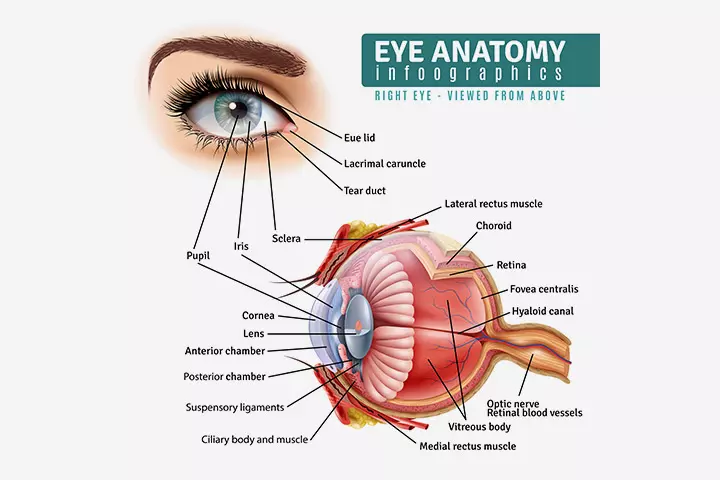
- Tear gland: Known as the lacrimal gland, it is an almond-shaped exocrine gland located at the outer corner of the eye. The gland secretes water, electrolytes, proteins, and mucin (lacrimal gland fluid). It is the major contributor to the aqueous humor. Each time the eye blinks, tears moisten the eye. Sometimes, the eyes produce more tears for protection, helping wash away unwanted foreign bodies, such as dust, smoke particles, and irritants (10).
- Choroid: It is a spongy vascular layer of the eye between the retina and the sclera. It delivers oxygen and nutrients to the outer half of the retina (11).

- Eyelids: It is the fold of skin that protects the eyes by closing them frequently. This motion of opening and closing of eyelids is voluntary but can also be involuntarily controlled by the brain (12).
- Eyelashes: These are hairs that grow around the edge of the eyelids. They function as dust catchers, trapping debris that can reach the eyes and cause infection or obstruction in vision. Eyelashes form an almost impenetrable barrier against foreign bodies (13).
- Eyebrows: To provide a clear vision for the eyes, the eyebrows help remove unwanted moisture, such as sweat and raindrops, from the eyes. The shape of the eyebrows helps channel the moisture to flow sideways from the eyes and serve in blocking bright light (13).
How Do The Eyes Work?
Our eyes act as an observer and sense the light generated by a light source or light rays reflected from objects. The light enters the cornea and pupil, and the iris controls the amount of light entering through the pupil. Then the light passes through the lens and is focused on the retina.
As the focused light hits the retina, the photoreceptors convert the light into nerve impulses. These impulses are carried through the optic nerve to the brain, where the brain processes and turns it into an image (14).

The eyes capture images in an upside-down form, and the brain flips the image, helping us see things the right side up.

Why Do Humans Have Two Eyes?
The two eyes provide a binocular vision needed for accurate depth perception. Our two eyes view an object from different angles, providing different perspectives of the object, and our brain compares and processes these two sets of information to form a single image (15). This process is called convergence. The two eyeballs give us a depth perception to glance at and compare two images and determine how far away an object is from us.

 Experts say
Experts say30 Facts About Eyes For Kids
Here are some interesting facts about our eyes (16) (17) (18) (19) (20).
- The ocular muscles are the most active muscles in the human body.
- Eyelashes have an average lifespan of five months.
- Newborn babies only make crying sounds, and their eyes cannot produce tears until they are around the age of two weeks, as their tear gland ducts are underdeveloped.
- The duration of a blink is 100–150 milliseconds on average.
- You blink about 12–15 times in one minute.
- The human eye has about two million moving parts that work to help you see.
- In most people, the eyes stop growing in their early 20s.
- The human eyes can have one of the sixteen different colors according to the Martin scale.
- Brown is the most common eye color in humans.
- A human can have two different-colored eyes. This difference in color in the two eyes of the same person is called heterochromia iridum (heterochromia iridis).
- Pupil is derived from the Latin word pupa, meaning doll.
- A retina scan is now commonly used for security purposes instead of the fingerprint scan. Fingerprints have 40 unique characteristics, whereas the iris has 256.
- The human eye can detect over 10 million colors, but it can’t detect ultraviolet and infrared lights.
- Our eyes focus on about 50 different objects every second.
- It is impossible to sneeze with your eyes open. Try it!
- The optic nerve contains more than a million nerve cells.
- We actually see with our brain and not our eyes. Our eyes capture light and send the data to the brain for forming images.
- Red eyes in photographs appear due to the light from the flash bouncing off our capillaries in the eyes.
- If the human eye were a digital camera, it would have a resolution of 576 megapixels. The iPhone 12 has 12 megapixels.
- It is believed that, initially, every human being had only brown eyes, and the other colors evolved gradually over a period of time.
- The first blue-eyed person is said to have lived 10,000 years ago. And every blue-eyed person in the world shares a common ancestor.
- Health conditions such as diabetes and high blood pressure can be detected during an eye test.
- With the right weather conditions and lighting, the human eye can see the light of a candle from 14 miles away.
- All babies are color blind at the time of birth. They can differentiate colors only two weeks after birth.
- People normally read 25% slower on a screen than on a paper.
- The fear of the eyes is called ommatophobia.
- Only one-sixth of the human eyeball is exposed.
- Everyone has one eye slightly stronger than the other eye.
- The nose gets runny when a person cries, as the tears drain into the nasal passages.
- The eyes can also get sunburned like the skin, and the condition is called photokeratitis, causing pain, redness, and tears. Wear good sunglasses to protect your eyes from UV rays.
Frequently Asked Questions
1. How big is a human eye?
A human adult eye is around 24.2mm transverse, 23.7mm sagittal, and 22.0–24.8 mm axial (21). The eyeball size is between 21mm and 27mm in transverse diameter.
2. Do eyes get smaller with age?
No. Eyes may change in shape with age but usually do not increase or decrease in size after they are entirely developed.
3. What is good eye hygiene?
Good eye hygiene includes avoiding rubbing eyes, especially with dirty fingers; wiping the eyes with a clean cloth; rinsing them with clean water, and not sharing towels and spectacles with others. Regular eye exams and protective eyewear are also crucial for maintaining eye health.
4. At what age is a child’s eye color permanent?
The American Academy of Pediatrics suggests that babies usually have a solid eye color by the time they are about a year old (21).
5. What is the science behind the evolution of the eye?
The eye, at its primitive form, served functions such as light detection, shading with dark pigment to sense light direction, and a connection to motor structures for light-responsive movement. While some organisms perform all three functions in one cell, the two-celled eye is widely recognized as the simplest accepted structure. The evolution of eyes started with the basic photoreceptor-pigment cell structures to complex eyes with muscle connections, lenses, and improved optics. An increased number of photoreceptors provided images with more details (22).
6. What are some common eye problems in children?
In children, the most common eye problems are refractive errors (like nearsightedness and farsightedness), amblyopia (lazy eye), binocular vision dysfunction (problem in eye muscle coordination and near vision), nystagmus (quick, involuntary back-and-forth eye movements), pediatric cataracts, stye and chalazion (lump on the edge of the eyelid, and strabismus (crossed eyes) (23) (24). Regular eye exams can help detect any eye problem in its early stages and help look for an effective treatment.
The eyes are an important organ that we may often take for granted. Share these informative and interesting facts about eyes for kids with your child and ignite their curiosity. These facts will encourage them to learn more about the functioning of their eyes. They may also encourage your kids to look up facts about the human brain for kids to further understand how they are connected to the eyes. These eye facts will encourage your child how a healthy diet, regular exercise, and stress-free life are essential to maintain optimum eye health. As a parent, you should also watch out for your child’s eye health and get them tested if they experience any discomfort while or after reading.
Infographic: Captivating Eye Facts That Will Leave Kids In Awe
When it comes to the fascinating realm of human eyes, a wealth of incredible information can captivate young minds. This infographic explores the astonishing marvels of our eyes, presenting mind-blowing facts that will fill children with wonder and curiosity.
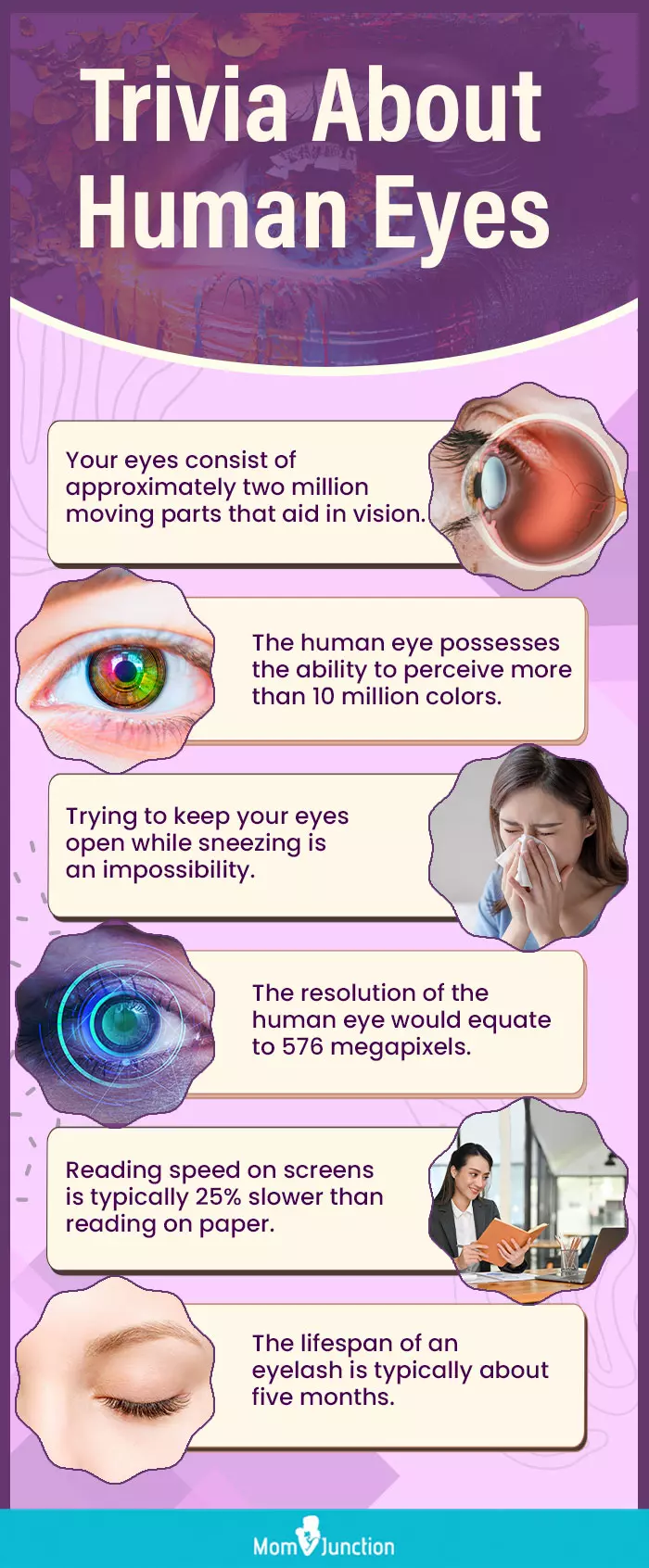
Illustration: Momjunction Design Team
Illustration: Amazing Facts About Human Eyes For Kids With Diagrams
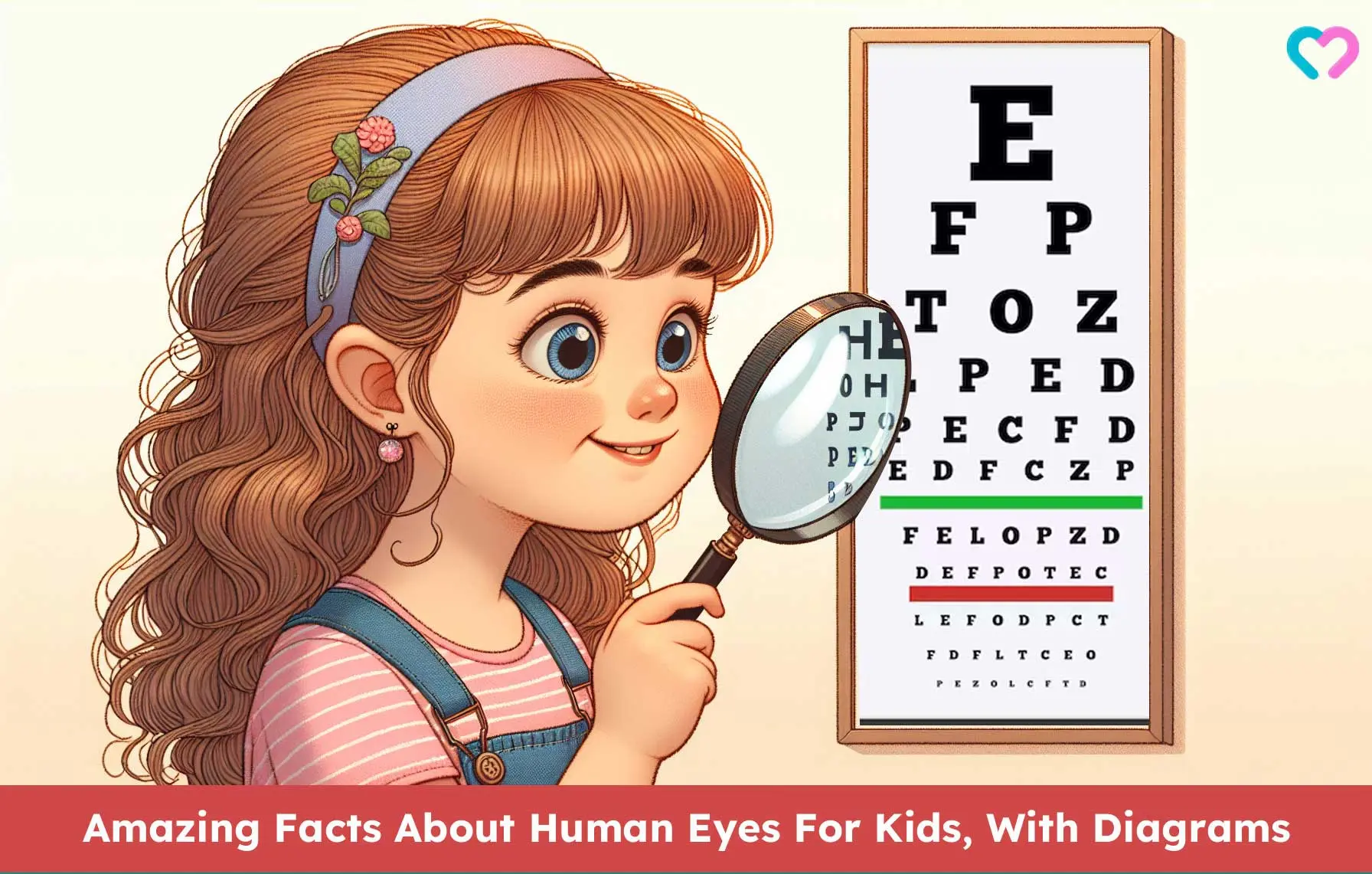
Image: Dall·E/MomJunction Design Team
Learn all about the amazing human eye! See how it works and helps us see the world around us. Discover the fascinating science behind vision!
References
1. Michael Tomasello, et al; Reliance on head versus eyes in the gaze following of great apes and human infants: the cooperative eye hypothesis; Journal of Human Evolution (2007).
2. Eye Anatomy; Glaucoma Research Foundation
3. FYI about your Eyes; Chicago Medicine
4. Anatomy of the Eye; Kellogg Eye Center
5. Jeffrey Bloom, Mahsaw Motlagh, and Craig N. Czyz; Anatomy, Head and Neck, Eye Iris Sphincter Muscle; StatPearls (2020).
6. Eye Health: Anatomy of the Eye; American Printing House for the Blind
7. Caleb L. Shumway, Mahsaw Motlagh, and Matthew Wade; Anatomy, Head and Neck, Eye Conjunctiva; StatPearls (2020).
8. Blind Spot; American Academy Of Ophthalmology
9. Aqueous Humor Flow and Function; BrightFocus Foundation
10. Darlene A. Dartt; Neural Regulation of Lacrimal Gland Secretory Processes: Relevance in Dry Eye Diseases; HHS Author Manuscripts (2009).
11. Debora L. Nickla and Josh Wallman; THE MULTIFUNCTIONAL CHOROID; HHS Author Manuscripts (2010).
12. Eyelid; American Academy Of Ophthalmology
13. Why Do Humans Have Eyebrows and Eyelashes?; American Academy Of Ophthalmology
14. How the Eyes Work; National Eye Institute
15. Depth Perception; American Academy Of Ophthalmology
16. CHANGING VISION? HOW TO MAKE SURE YOUR EYES ARE HEALTHY; University of Utah Health Hospitals and Clinics
17. 20 Facts About the Amazing Eye; Discovery Eye Foundation
18. Fun Facts About Eyes; St. Hope Foundation
19. 101 Amazing Eye Facts; Lenstore Vision Hub
20. 15 Things That Will Surprise you About the Human Eye; SelectHealth
21. What Color Will My Baby’s Eyes Be?; Healthy Children
22. Eye Evolution; Genetic Science Learning Center
23. Sunglasses: Your Prescription for Eye Health; American Academy Of Ophthalmology
24. 7 Common Pediatric Eye Conditions; Optometrists Network
25. Childhood Eye Diseases and Conditions: American Academy of Ophthalmology
Community Experiences
Join the conversation and become a part of our nurturing community! Share your stories, experiences, and insights to connect with fellow parents.
Read full bio of Maria Carmela Villania-Mamauag
Read full bio of Dr Bisny T. Joseph
Read full bio of Harshita Makvana
Read full bio of Shinta Liz Sunny














